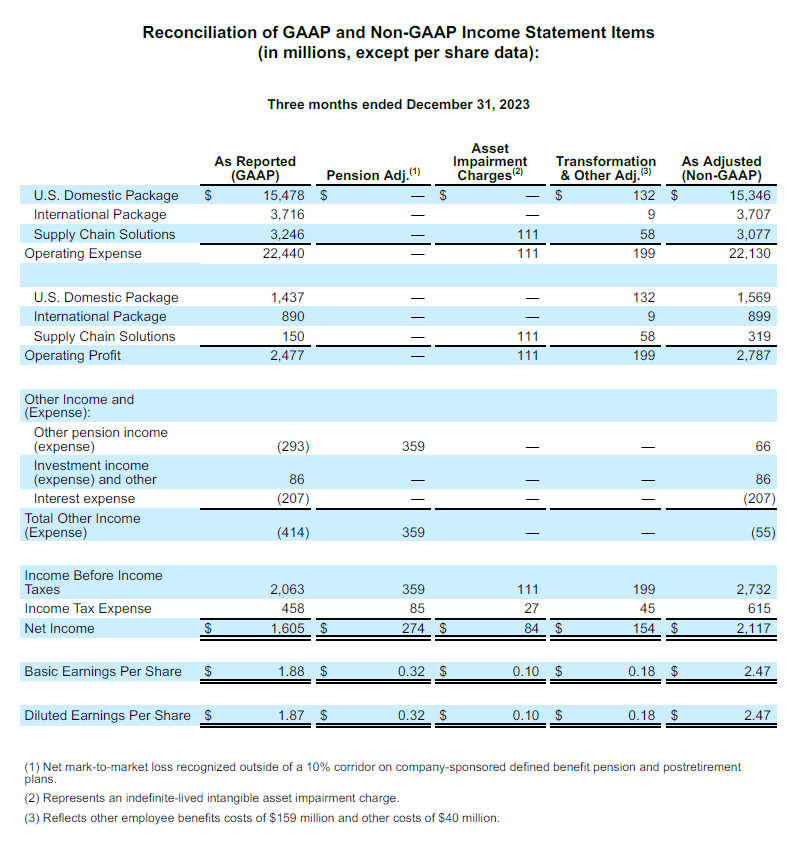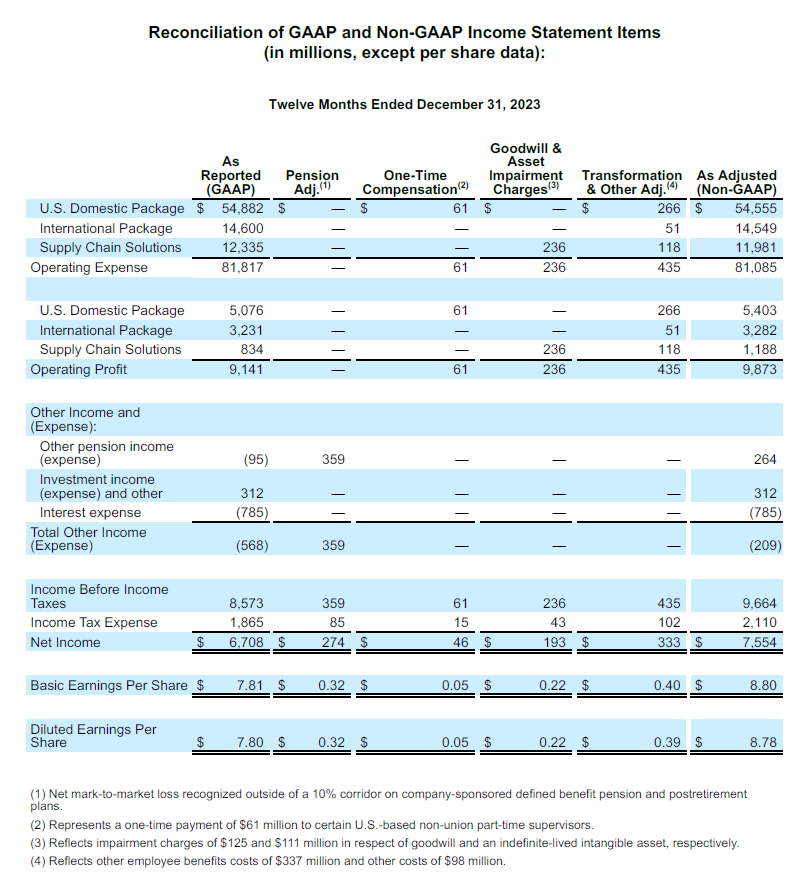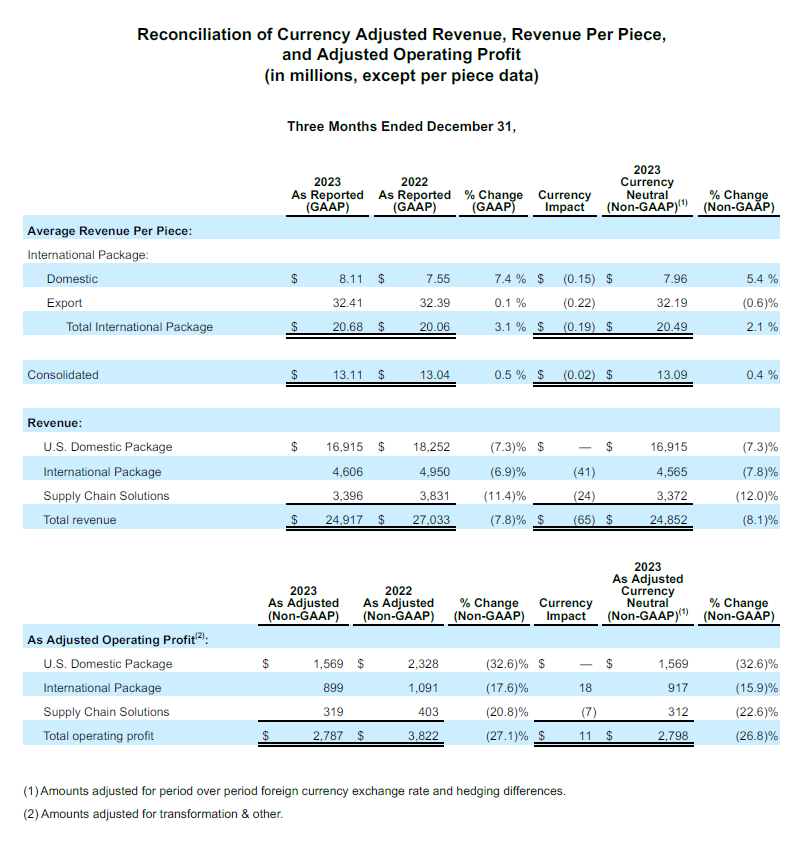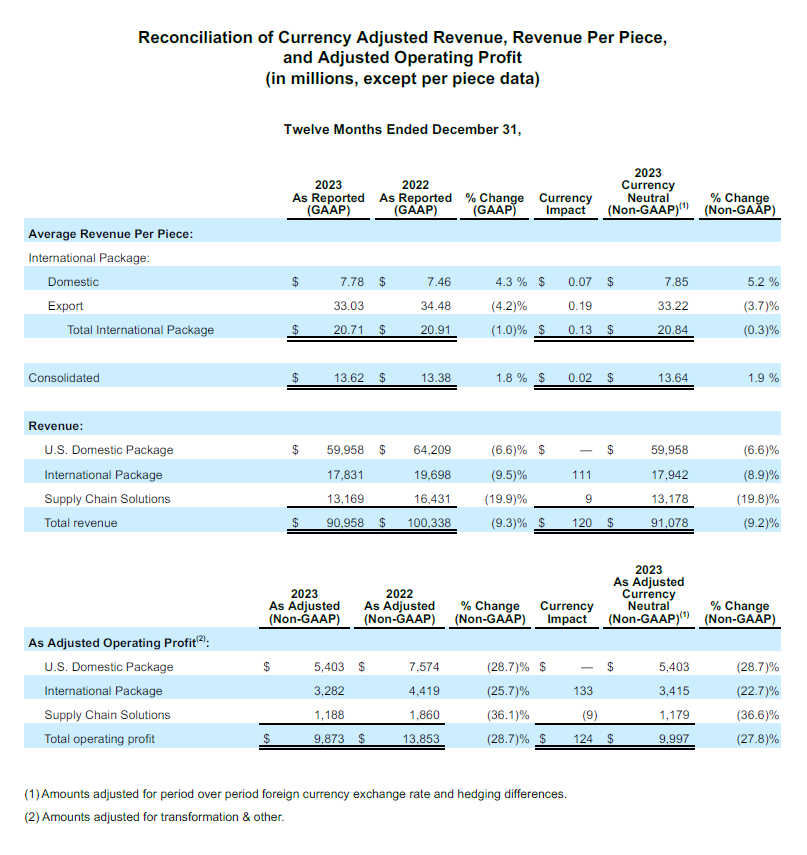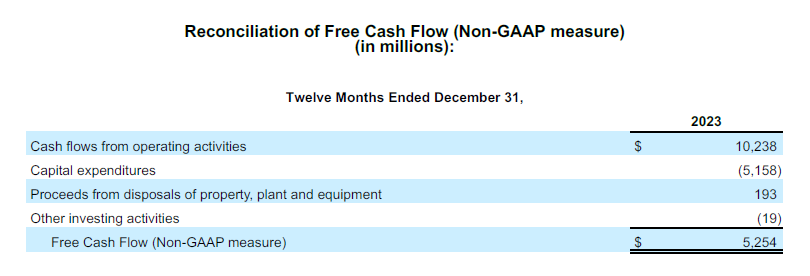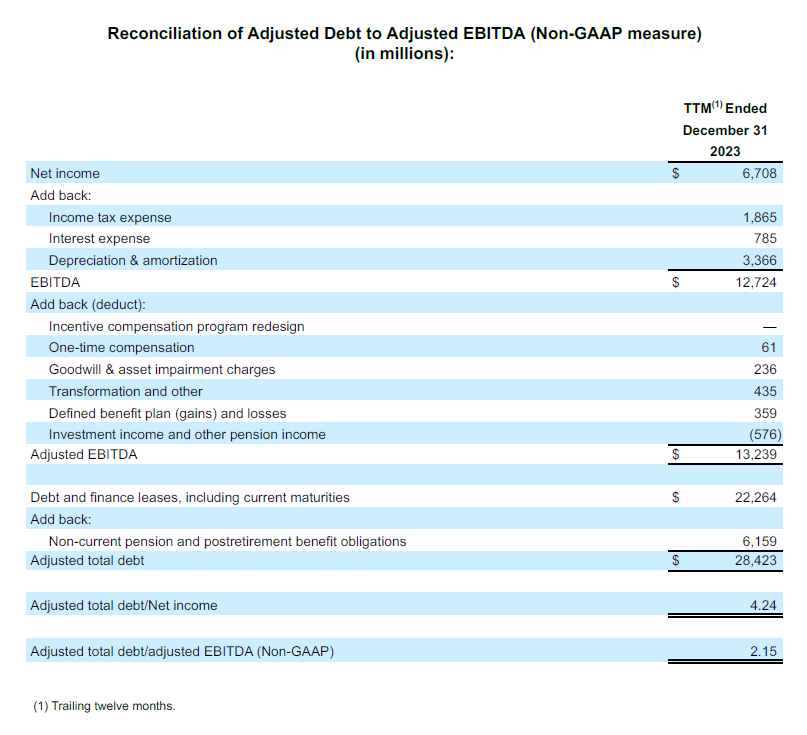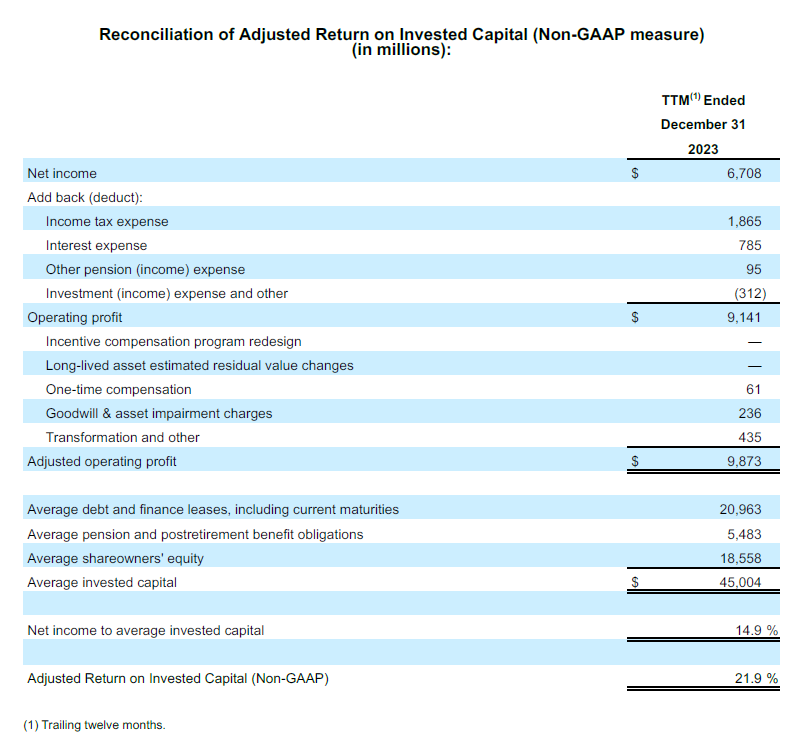- Consolidated Revenues of $24.9B, Compared to $27.0B Last Year
- Consolidated Operating Margin of 9.9%; Adjusted* Consolidated Operating Margin of 11.2%
- Diluted EPS of $1.87; Adj. Diluted EPS of $2.47, Compared to $3.62 Last Year
- Declares a Quarterly Dividend of $1.63, a $0.01 Increase Per Share
ATLANTA – January 30, 2024 – UPS (NYSE:UPS) today announced fourth-quarter 2023 consolidated revenues of $24.9 billion, a 7.8% decrease from the fourth quarter of 2022. Consolidated operating profit was $2.5 billion, down 22.5% compared to the fourth quarter of 2022, and down 27.1% on an adjusted basis. Diluted earnings per share were $1.87 for the quarter; adjusted diluted earnings per share of $2.47 were 31.8% below the same period in 2022.
For the fourth quarter of 2023, GAAP results include a total charge of $512 million, or $0.60 per diluted share, comprised of a non-cash, after-tax mark-to-market (MTM) pension charge of $274 million, after-tax transformation and other charges of $154 million, and a non-cash, after-tax impairment charge of $84 million related to our Coyote trade name in our truckload brokerage unit.
“I want to thank UPSers for providing the best on-time performance of any carrier for the sixth year in a row,” said Carol Tomé, UPS chief executive officer. “2023 was a unique and difficult year and through it all we remained focused on controlling what we could control, stayed on strategy and strengthened our foundation for future growth.”
U.S. Domestic Segment
|
4Q 2023 | Adjusted 4Q 2023 |
4Q 2022 | Adjusted 4Q 2022 |
Revenue | $16,915 M |
| $18,252 M |
|
Operating profit | $1,437 M | $1,569 M | $1,840 M | $2,328 M |
- Revenue decreased 7.3%, driven by a 7.4% decrease in average daily volume.
- Operating margin was 8.5%; adjusted operating margin was 9.3%.
International Segment
|
4Q 2023 | Adjusted 4Q 2023 |
4Q 2022 | Adjusted 4Q 2022 |
Revenue | $4,606 M |
| $4,950 M |
|
Operating profit | $890 M | $899 M | $1,020 M | $1,091 M |
- Revenue decreased 6.9%, driven by an 8.3% decrease in average daily volume primarily due to softness in Europe.
- Operating margin was 19.3%; adjusted operating margin was 19.5%.
Supply Chain Solutions1
|
4Q 2023 | Adjusted 4Q 2023 |
4Q 2022 | Adjusted 4Q 2022 |
Revenue | $3,396 M |
| $3,831 M |
|
Operating profit | $150 M | $319 M | $335 M | $403 M |
1 Consists of operating segments that do not meet the criteria of a reportable segment under ASC Topic 280 – Segment Reporting.
- Revenue decreased 11.4% due primarily to market rate declines and excess market capacity in forwarding.
- Operating margin was 4.4%; adjusted operating margin was 9.4%.
Full-Year 2023 Consolidated Results
- Revenue was $91.0 billion, a decrease of 9.3%.
- Operating profit of $9.1 billion; adjusted operating profit of $9.9 billion, down 28.7%.
- Operating margin was 10.0%; adjusted operating margin was 10.9%.
- Diluted EPS totaled $7.80; adjusted diluted EPS of $8.78.
- Adjusted return on invested capital was 21.9%.
- Cash from operations was $10.2 billion and free cash flow was $5.3 billion.
In addition, the Company returned $7.6 billion of cash to shareowners through dividends and share buybacks.
Dividend Declaration
For the 15th consecutive year, the UPS Board of Directors has approved an increase to the company’s quarterly dividend. UPS will pay a first-quarter 2024 dividend of $1.63 per share on all outstanding Class A and Class B shares. The dividend is payable March 8, 2024 to shareowners of record on February 20, 2024.
2024 Outlook
The company provides certain guidance on an adjusted (non-GAAP) basis because it is not possible to predict or provide a reconciliation reflecting the impact of future pension adjustments or other unanticipated events, which would be included in reported (GAAP) results and could be material.
For the full year 2024, UPS expects revenue to range from approximately $92.0 billion to $94.5 billion and consolidated adjusted operating margin to range from approximately 10.0% to 10.6%.
The company is planning capital expenditures of about $4.5 billion and dividend payments of around $5.4 billion, subject to board approval. The effective tax rate is expected to be around 23.5%.
* “Adjusted” or “Adj.” amounts are non-GAAP financial measures. See the appendix to this release for a discussion of non-GAAP financial measures, including a reconciliation to the most closely correlated GAAP measure.
Contacts:
UPS Media Relations: 404-828-7123 or pr@ups.com
UPS Investor Relations: 404-828-6059 (option 4) or investor@ups.com
# # #
Conference Call Information
UPS CEO Carol Tomé and CFO Brian Newman will discuss fourth-quarter results with investors and analysts during a conference call at 8:30 a.m. ET, January 30, 2024. That call will be open to others through a live Webcast. To access the call, go to www.investors.ups.com and click on “Earnings Conference Call.” Additional financial information is included in the detailed financial schedules being posted on www.investors.ups.com under “Quarterly Earnings and Financials” and as furnished to the SEC as an exhibit to our Current Report on Form 8-K.
About UPS
UPS (NYSE: UPS) is one of the world’s largest companies, with 2023 revenue of $91.0 billion, and provides a broad range of integrated logistics solutions for customers in more than 200 countries and territories. Focused on its purpose statement, “Moving our world forward by delivering what matters,” the company’s approximately 500,000 employees embrace a strategy that is simply stated and powerfully executed: Customer First. People Led. Innovation Driven. UPS is committed to reducing its impact on the environment and supporting the communities we serve around the world. UPS also takes an unwavering stance in support of diversity, equity and inclusion. More information can be found at www.ups.com, about.ups.com and www.investors.ups.com.
Forward-Looking Statements
This release, our Annual Report on Form 10-K for the year ended December 31, 2022 and our other filings with the Securities and Exchange Commission contain and in the future may contain “forward-looking statements” within the meaning of the Private Securities Litigation Reform Act of 1995. Statements other than those of current or historical fact, and all statements accompanied by terms such as “will,” “believe,” “project,” “expect,” “estimate,” “assume,” “intend,” “anticipate,” “target,” “plan,” and similar terms, are intended to be forward-looking statements. Forward-looking statements are made subject to the safe harbor provisions of the federal securities laws pursuant to Section 27A of the Securities Act of 1933 and Section 21E of the Securities Exchange Act of 1934.
From time to time, we also include written or oral forward-looking statements in other publicly disclosed materials. Forward-looking statements may relate to our intent, belief, forecasts of, or current expectations about our strategic direction, prospects, future results, or future events; they do not relate strictly to historical or current facts. Management believes that these forward-looking statements are reasonable as and when made. However, caution should be taken not to place undue reliance on any forward-looking statements because such statements speak only as of the date when made and the future, by its very nature, cannot be predicted with certainty.
Forward-looking statements are subject to certain risks and uncertainties that could cause actual results to differ materially from our historical experience and our present expectations or anticipated results. These risks and uncertainties, include, but are not limited to the impact of: continued uncertainties related to the COVID-19 pandemic; changes in general economic conditions, in the U.S. or internationally; industry evolution and significant competition; changes in our relationships with any of our significant customers; our ability to attract and retain qualified employees; strikes, work stoppages or slowdowns by our employees; results of negotiations and ratifications of labor contracts; our ability to maintain our brand image and corporate reputation; increased or more complex physical security requirements; a significant data breach or information technology system disruption; global climate change; interruptions in or impacts on our business from natural or man-made events or disasters including terrorist attacks, epidemics or pandemics; exposure to changing economic, political and social developments in international markets; our ability to realize the anticipated benefits from acquisitions, dispositions, joint ventures or strategic alliances; changing prices of energy, including gasoline, diesel and jet fuel, or interruptions in supplies of these commodities; changes in exchange rates or interest rates; our ability to accurately forecast our future capital investment needs; significant expenses and funding obligations relating to employee health, retiree health and/or pension benefits; our ability to manage insurance and claims expenses; changes in business strategy, government regulations, or economic or market conditions that may result in impairments of our assets; potential additional U.S. or international tax liabilities; increasingly stringent laws and regulations, including relating to climate change; potential claims or litigation related to labor and employment, personal injury, property damage, business practices, environmental liability and other matters; and other risks discussed in our filings with the Securities and Exchange Commission from time to time, including our Annual Report on Form 10-K for the year ended December 31, 2022, and subsequently filed reports. You should consider the limitations on, and risks associated with, forward-looking statements and not unduly rely on the accuracy of predictions contained in such forward-looking statements. We do not undertake any obligation to update forward-looking statements to reflect events, circumstances, changes in expectations, or the occurrence of unanticipated events after the date of those statements, except as required by law.
From time to time, we expect to participate in analyst and investor conferences. Materials provided or displayed at those conferences, such as slides and presentations, may be posted on our investor relations website at www.investors.ups.com under the heading "Presentations" when made available. These presentations may contain new material nonpublic information about our company and you are encouraged to monitor this site for any new posts, as we may use this mechanism as a public announcement.
Reconciliation of GAAP and Non-GAAP Financial Measures
We supplement the reporting of our financial information determined under generally accepted accounting principles ("GAAP") with certain non-GAAP financial measures.
Adjusted financial measures should be considered in addition to, and not as an alternative for, our reported results prepared in accordance with GAAP. Our adjusted financial measures do not represent a comprehensive basis of accounting and therefore may not be comparable to similarly titled measures reported by other companies.
Forward-Looking Non-GAAP Metrics
From time to time when presenting forward-looking non-GAAP metrics, we are unable to provide quantitative reconciliations to the most closely correlated GAAP measure due to the uncertainty in the timing, amount or nature of any adjustments, which could be material in any period.
Changes in Foreign Currency Exchange Rates and Hedging Activities
We supplement the reporting of revenue, revenue per piece and operating profit with adjusted measures that exclude the period-over-period impact of foreign currency exchange rate changes and hedging activities. We believe currency-neutral revenue, revenue per piece and operating profit information allows users of our financial statements to understand growth trends in our products and results. We evaluate the performance of International Package and Supply Chain Solutions on this currency-neutral basis.
Currency-neutral revenue, revenue per piece and operating profit are calculated by dividing current period reported U.S. Dollar revenue, revenue per piece and operating profit by the current period average exchange rates to derive current period local currency revenue, revenue per piece and operating profit. The derived amounts are then multiplied by the average foreign currency exchange rates used to translate the comparable results for each month in the prior year period (including the period-over-period impact of foreign currency hedging activities). The difference between the current period reported U.S. Dollar revenue, revenue per piece and operating profit and the derived current period U.S. Dollar revenue, revenue per piece and operating profit is the period-over-period impact of currency fluctuations.
Incentive Compensation Program Design Changes
During 2022, we completed certain structural changes to the design of our incentive compensation programs that resulted in a one-time, non-cash charge in connection with the accelerated vesting of certain equity incentive awards that we do not expect to repeat. We supplement the presentation of our operating profit, operating margin, income before income taxes, net income and earnings per share with non-GAAP measures that exclude the impact of these changes. We believe excluding the impacts of such changes allows users of our financial statements to more appropriately identify underlying growth trends in compensation and benefits expense.
Long-lived Asset Estimated Residual Value Changes
During the fourth quarter of 2022, we incurred a one-time, non-cash charge resulting from a reduction in the estimated residual value of our MD-11 fleet. We supplement the presentation of our operating profit, operating margin, income before income taxes, net income and earnings per share with non-GAAP measures that exclude the impact of this charge. We believe excluding the impact of this charge better enables users of our financial statements to understand the ongoing cost associated with our long-lived assets.
Transformation Charges, and Goodwill, Asset Impairment and Divestiture Charges
We supplement the presentation of our operating profit, operating margin, income before income taxes, net income and earnings per share with non-GAAP measures that exclude the impact of charges related to transformation activities, and goodwill, asset impairment and divestiture charges. We believe excluding the impact of these charges better enables users of our financial statements to view and evaluate underlying business performance from the perspective of management. We do not consider these costs when evaluating the operating performance of our business units, making decisions to allocate resources or in determining incentive compensation awards.
One-Time Compensation Payment
We supplement the presentation of our operating profit, operating margin, income before income taxes, net income and earnings per share with non-GAAP measures that exclude the impact of a one-time payment made to certain U.S.-based, non-union part-time supervisors following the ratification of our labor agreement with the Teamsters. We do not expect this or similar payments to recur. We believe excluding the impact of this one-time payment better enables users of our financial statements to view and evaluate underlying business performance from the same perspective as management.
Defined Benefit Pension and Postretirement Medical Plan Gains and Losses
We recognize changes in the fair value of plan assets and net actuarial gains and losses in excess of a 10% corridor (defined as 10% of the greater of the fair value of plan assets or the plan's projected benefit obligation), as well as gains and losses resulting from plan curtailments and settlements, for our pension and postretirement defined benefit plans immediately as part of Investment income and other in the statements of consolidated income. We supplement the presentation of our income before income taxes, net income and earnings per share with adjusted measures that exclude the impact of these gains and losses and the related income tax effects. We believe excluding these defined benefit pension and postretirement medical plan gains and losses provides important supplemental information by removing the volatility associated with plan amendments and short-term changes in market interest rates, equity values and similar factors.
Free Cash Flow
We calculate free cash flow as cash flows from operating activities less capital expenditures, proceeds from disposals of property, plant and equipment, and plus or minus the net changes in other investing activities. We believe free cash flow is an important indicator of how much cash is generated by our ongoing business operations and we use this as a measure of incremental cash available to invest in our business, meet our debt obligations and return cash to shareowners.
Adjusted Return on Invested Capital
Adjusted ROIC is calculated as the trailing twelve months (“TTM”) of adjusted operating income divided by the average of total debt, non-current pension and postretirement benefit obligations and shareowners’ equity, at the current period end and the corresponding period end of the prior year. Because adjusted ROIC is not a measure defined by GAAP, we calculate it, in part, using non-GAAP financial measures that we believe are most indicative of our ongoing business performance. We consider adjusted ROIC to be a useful measure for evaluating the effectiveness and efficiency of our long-term capital investments.
Adjusted Total Debt / Adjusted EBITDA
Adjusted total debt is defined as our long-term debt and finance leases, including current maturities, plus non-current pension and postretirement benefit obligations. Adjusted EBITDA is defined as earnings before interest, taxes, depreciation and amortization adjusted for the impacts of incentive compensation program redesign, one-time compensation, goodwill & asset impairment charges, transformation and other costs, defined benefit plan gains and losses and other income. We believe the ratio of adjusted total debt to adjusted EBITDA is an important indicator of our financial strength, and is a ratio used by third parties when evaluating the level of our indebtedness.



